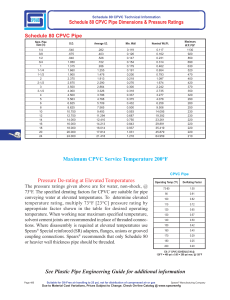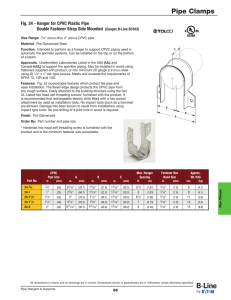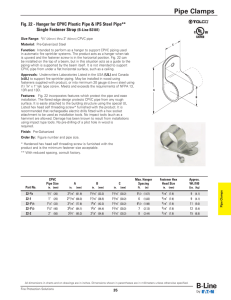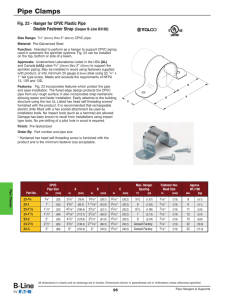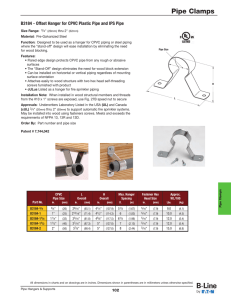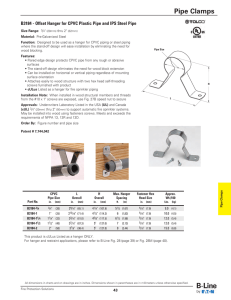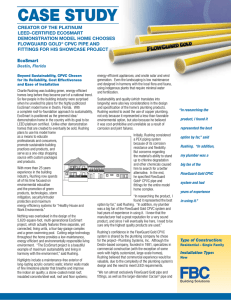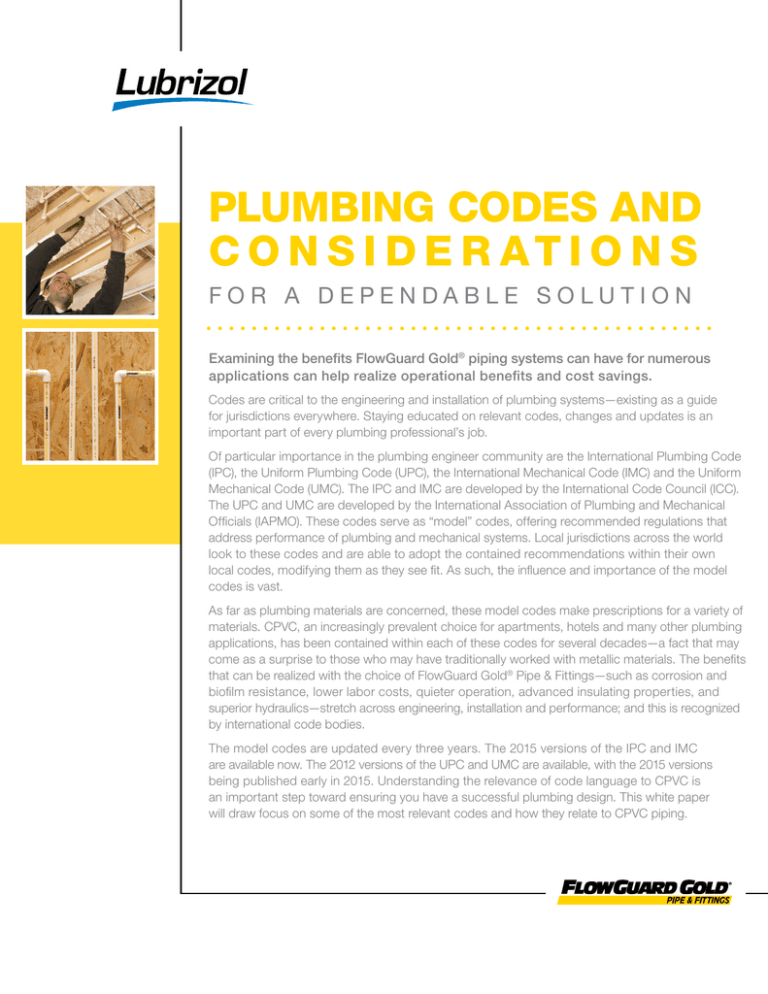
PLUMBING CODES AND
C O N S I D E R AT I O N S
FOR A DEPENDABLE SOLUTION
Examining the benefits FlowGuard Gold® piping systems can have for numerous
applications can help realize operational benefits and cost savings.
Codes are critical to the engineering and installation of plumbing systems—existing as a guide
for jurisdictions everywhere. Staying educated on relevant codes, changes and updates is an
important part of every plumbing professional’s job.
Of particular importance in the plumbing engineer community are the International Plumbing Code
(IPC), the Uniform Plumbing Code (UPC), the International Mechanical Code (IMC) and the Uniform
Mechanical Code (UMC). The IPC and IMC are developed by the International Code Council (ICC).
The UPC and UMC are developed by the International Association of Plumbing and Mechanical
Officials (IAPMO). These codes serve as “model” codes, offering recommended regulations that
address performance of plumbing and mechanical systems. Local jurisdictions across the world
look to these codes and are able to adopt the contained recommendations within their own
local codes, modifying them as they see fit. As such, the influence and importance of the model
codes is vast.
As far as plumbing materials are concerned, these model codes make prescriptions for a variety of
materials. CPVC, an increasingly prevalent choice for apartments, hotels and many other plumbing
applications, has been contained within each of these codes for several decades—a fact that may
come as a surprise to those who may have traditionally worked with metallic materials. The benefits
that can be realized with the choice of FlowGuard Gold® Pipe & Fittings—such as corrosion and
biofilm resistance, lower labor costs, quieter operation, advanced insulating properties, and
superior hydraulics—stretch across engineering, installation and performance; and this is recognized
by international code bodies.
The model codes are updated every three years. The 2015 versions of the IPC and IMC
are available now. The 2012 versions of the UPC and UMC are available, with the 2015 versions
being published early in 2015. Understanding the relevance of code language to CPVC is
an important step toward ensuring you have a successful plumbing design. This white paper
will draw focus on some of the most relevant codes and how they relate to CPVC piping.
ALLOWANCE OF CPVC IN THE CODES
SOLVENT WELDING
IPC:
• CPVC pipe and fittings are allowed for water service and
distribution application per sections 605.3, 605.4 and 605.5.
Solvent welding is a key component of a CPVC piping system
installation and is responsible for many of the benefits that can
come from choosing to specify FlowGuard Gold pipe and fittings.
• CPVC pipe and fittings are allowed for use in discharge piping
serving a temperature relief valve per 504.6.
In this process, the outside of the pipe molecularly bonds
to the inside of the fitting socket, allowing for full water flow
without restrictions in cross-sectional flow areas that occur
with insert-style fittings. This no-heat, no-flame process
eliminates many of the safety issues that can arise with other
plumbing materials. A cleaner and quicker process than
common metallic joining methods, the solvent-welding process
complements the inherent ease of installation of CPVC with
its ability to be quickly cut and rerouted if necessary. For a full
description of the proper solvent-welding process, refer to your
pipe, fitting and solvent cement manufacturers’ instructions.
UPC:
• CPVC pipe and fittings are allowed for building service
and distribution application per section 604.1.
• CPVC pipe and fittings are allowed for use in temperature
and pressure relief valve drain tube per 608.5.
IMC:
• CPVC is allowed for use as condensate disposal per 307.2.2.
• CPVC pipe is allowed for use as hydronic pipe per 1202.4.
• CPVC fittings are allowed for use as hydronic fittings
per 1202.5.
UMC:
• CPVC is an approved corrosion-resistant material that
is allowed for use as condensate disposal per 312.1.
• CPVC pipe is allowed for use as hydronic pipe per 1201.3.1.
• CPVC fittings are allowed for use as hydronic fittings
per 1202.5.
2015 UPDATES
First, a few notable updates to the 2015 version of the code
are as follows. Importantly, these updates incorporate the use
of hybrid CPVC/Aluminum/CPVC piping into several applications.
IPC:
• CPVC and CPVC/Aluminum/CPVC pipe are allowed
for use as water service pipe per section 605.3.
• CPVC and CPVC/Aluminum/CPVC pipe are allowed
for use as distribution pipe per section 605.4.
IMC:
• CPVC pipe is allowed for use as ground-source heat
pump-loop piping per 1210.4.
• CPVC fittings are allowed for use as ground-source
heat pump-loop fittings per 1210.5.
IPC, UPC and IMC outline several considerations when it comes
to solvent cement. They are as follows:
IPC:
• CPVC Solvent Cement joints should be made according
to 605.15.2.
- Primer is required unless instruction allows for one-step
solvent cement certified ASTM F493—this cement is often
yellow in color.
• CPVC/Aluminum/CPVC Solvent Cement joints should be made
according to 605.16.2.
- Primer is required unless instruction allows for one-step solvent
cement certified to ASTM F493 (yellow in color) and is only
used to join ½" to 2" diameter CPVC/Aluminum/CPVC pipe
and CPVC fittings (those fittings conforming to ASTM D2846).
UPC:
• CPVC Solvent Cement joints should be made according to 605.4.
- Primer is not required if solvent cement meets F493, is yellow
or red in color, and pipe and fitting are ½" to 2" in diameter
and manufactured to ASTM D2846.
IMC:
• CPVC Solvent Cement joints should be made according
to 1203.3.4.
- Primer is required unless solvent cement is certified to ASTM
F493, yellow in color, only used to join ½" to 2" diameter CPVC
and CPVC fittings are manufactured to ASTM D2846.
Per these codes, plumbing professionals can seek out one-step
solvent cement to circumvent the process of applying primer,
helping to streamline the process of a CPVC installation.
SIZING REQUIREMENTS
The sizing of CPVC piping is directly comparable and interchangeable with that of copper. The ½" to 2" FlowGuard Gold piping conforms
to Copper Tube Size (CTS) SDR 11 dimensions. FlowGuard Gold piping is fully compatible with CTS solvent-welded fittings and transition
adaptors. Additionally, since the system uses full-flow injection molded fittings, there are no concerns about increased water velocity
at the connection.
COMBUSTIBLE VS. NONCOMBUSTIBLE CONSTRUCTION
An important consideration when choosing building materials is that of their combustibility—flammable products can contribute
to greater risk of catastrophic fire damage to a structure. While this is not accounted for within the plumbing and mechanical codes,
standards pertaining to combustibility of plumbing materials are prescribed within the International Building Code (IBC), developed
through the International Code Council. IBC has been widely adopted through much of the United States, and its influence is wide.
As of the 2015 version of the IBC, CPVC pipe is allowed for use in noncombustible construction per section 603.1.2 of the code:
• The use of combustible piping materials shall be permitted where installed in accordance with the limitations of the
International Mechanical Code and the International Plumbing Code.
PENETRATING FIRE-RATED ASSEMBLIES
Flammability concerns extend to another part of the IBC. When a piping assembly penetrates a fire-rated wall or other such assembly,
it must be used with a listed firestop material. The firestop holds this listing for the type of construction and the material penetrating
the fire-rated wall/assembly.
The reference is as follows, per section 714.3.1.2:
• Through penetrations shall be protected by an approved penetration firestop system installed as tested in accordance with ASTM E814
or UL 1479, with a minimum positive pressure differential of 0.01 inch (2.49 Pa) of water and shall have an F rating of not less than
the required fire-resistance rating of the wall penetrated.
Firestops compatible with Lubrizol CPVC brands (FlowGuard Gold, BlazeMaster and Corzan) can be found
at www.fbcsystemcompatible.com.
USE IN PLENUM SPACES
It is common of many commercial buildings that the area directly above a suspended ceiling is used as an air plenum. Per 2015 IMC 602.2:
• Except as required by sections 602.2.1.1 through 602.2.1.5, materials within plenums shall be noncombustible or shall be listed
and labeled as having a flame-spread index of not more than 25 and a smoke-developed index of not more than 50 when tested
in accordance with ASTM E84 or UL 723.
Similar language is reflected within the 2012 UMC:
• Materials exposed within ducts or plenums shall be noncombustible or shall have a flame-spread index not to exceed 25 and
a smoke-developed index not to exceed 50, where tested as a composite product in accordance with ASTM E84 or UL 723.
The 2012 version of the UMC does not currently require that the product be listed and labeled, but it is expected that
the 2015 version (currently under development) will incorporate the listed and labeled requirement.
FlowGuard Gold piping systems have, for decades, been approved by code officials within the requirements set by this section
of the code. Various tests are used to evaluate the surface-burning characteristics of construction materials, and most commonly,
these materials must meet a 25/50 flame-spread/smoke-developed rating when tested in accordance with ASTM E84. For reference,
asbestos cement has a 0/0 flame-spread/smoke-developed rating, while red oak has a 100/100 flame-spread/smoke-developed rating.
The listing for Corzan® and FlowGuard Gold can be found here.
FlowGuard Gold piping has been listed by ICC-ES under PMG 1264. The listed models have been tested in both water-filled and dry
applications, in general accordance with UL 723/ASTM E84 test methods for surface-burning characteristics, and have been found
to meet the 25/50 flame-spread/smoke-developed requirements of the IMC and UMC for installation in ducts and plenums.
Always check local jurisdictions before using in a plenum.
The listed models are:
• ½"–2" water-filled FlowGuard Gold pipe and fittings have a flame-spread index of no more than 5
and a smoke-developed index of no more than 35.
• ½" dry FlowGuard Gold pipe and fittings for condensate lines have a flame-spread index of no more than 5
and a smoke-developed index of no more than 25.
LISTED AND LABELED
When considering CPVC, engineers should keep in mind two words that denote a quality product: “listed” and “labeled.”
FlowGuard Gold pipe and fittings from selected manufacturers meet both of these requirements: listed by third parties certifying specific
and heightened performance standards, and labeled directly on the pipe to denote the most important material standards. By ensuring
that your piping products are listed and labeled, engineers can gain peace of mind in the anticipated performance of the FlowGuard Gold
piping system for a long-lasting and efficient plumbing solution.
ADDITIONAL INFORMATION
The interconnected web of codes, standards, listings and approvals that affects the plumbing industry is a complex, ever-changing concern.
Lubrizol CPVC is dedicated to providing support and education for those who work with its CPVC piping systems. Beyond the scope
of this paper, engineers are encouraged to contact their Lubrizol CPVC piping systems consultant to clarify any code issues that
arise—Lubrizol CPVC’s code experts continually research and examine codes of all types and are happy to provide assistance
in navigating code concerns.
These services are part of the way Lubrizol CPVC is dedicated to its customers—from job-site training and support, to cost-effective
solutions, to market leadership, choosing FlowGuard Gold Pipe & Fittings and a partnership with Lubrizol CPVC can ensure project
success across a variety of residential and commercial plumbing applications. It’s MORE INSIDE.™
To learn more about FlowGuard Gold Pipe & Fittings,
visit flowguardgold.com or call a piping systems consultant
at 1.855.735.1431.
Sign up for our eNewsletter,
Plumbing Connections.
Follow us on Twitter @LZ_CPVC
© 2014 The Lubrizol Corporation, all rights reserved. All marks are the property of The Lubrizol Corporation.
The Lubrizol Corporation is a Berkshire Hathaway company.
PL-US-CODEWP
GC 141419
Nov 2014

